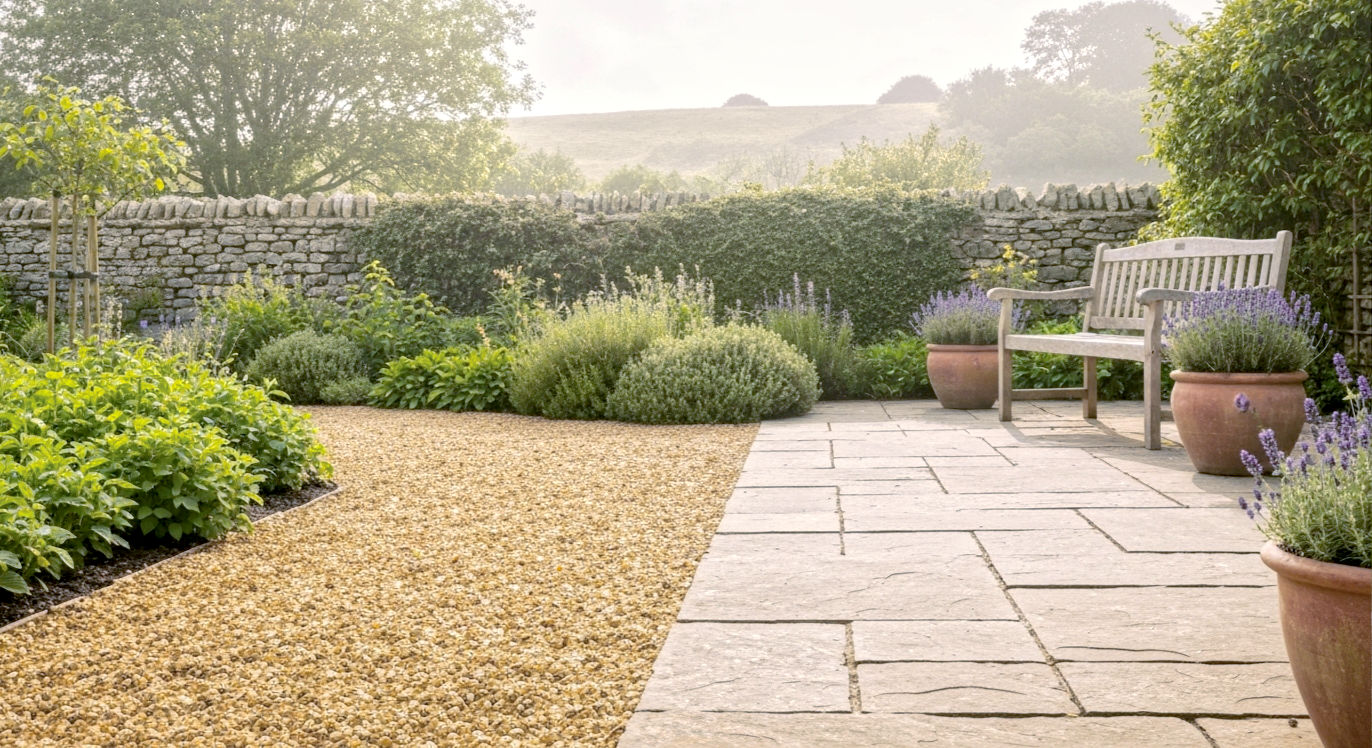The Guide to Stone Landscaping in Your British Garden
The definitive guide to transforming your British garden with stone. Explore ideas for paths, patios, walls, and features, with practical tips and DIY projects.

This post may contain affiliate links. If you make a purchase through these links, we may earn a commission at no additional cost to you.
Picture this: a classic honey-coloured cottage in the Cotswolds, with a satisfyingly crunchy gravel drive. Or maybe a sharp, modern London garden where dark slate chippings make the bright green ferns pop. What’s the common thread? It’s stone. More than just a pile of rocks, stone is the backbone of British gardens, big and small. It’s been that way for centuries, from the mysterious standing stones of our ancestors to the grand paved terraces of stately homes.
Using stone in your garden isn’t just about looking good, though it certainly helps. It’s practical. It’s durable. It creates texture, structure, and a sense of permanence that flighty flowerbeds sometimes lack. A well-placed path guides your eye (and your feet), a sturdy wall creates a secret garden room, and a thoughtfully built rockery becomes a miniature mountain landscape for tiny, fascinating plants.
So, if you’ve ever thought your garden was missing a bit of heft, a bit of character, you’re in the right place. This is your ultimate guide to understanding, choosing, and using stone to transform your outdoor space. We’ll cover everything from the different types of rock you can buy to how to build a simple path without calling in the professionals. Don’t worry, it’s not as heavy-going as it sounds. Let’s dig in.
The A-Z of Garden Stone: Getting to Know Your Rocks
Before you rush off to the garden centre, it helps to know what you’re looking at. The world of garden stone can seem a bit baffling at first, with its talk of aggregates, scree, and setts. But it’s actually pretty simple when you break it down. Think of it like a chef choosing ingredients: some are for the main structure, and some are for flavour and decoration.
It’s Not All Grey: A Rainbow of Stone Types
Stone comes in a surprising variety of colours, textures, and moods. Choosing the right one can make the difference between a garden that feels like a natural extension of your home and one that looks like a builder just left their leftovers.
- Sandstone: This is a British classic. Think of the golden-brown slabs of Yorkstone, which have paved the streets of our northern towns for centuries. It’s warm, inviting, and has a slightly rustic feel. It’s brilliant for patios and paths because it’s not too slippery when wet. It comes in a range of colours, from sandy yellow and buff to reddish-brown and grey.
- Limestone: If you’re after a paler, creamier look, limestone is your friend. The famous Cotswold chippings are a type of limestone, giving that classic, buttery-yellow crunch to drives and paths across the country. One thing to remember: limestone is alkaline, which means it will slowly raise the pH of your soil. This is fine for many plants (like lavender and poppies), but it’s bad news for acid-loving ones like rhododendrons and camellias.
- Slate: For a sleek, modern look, you can’t beat slate. It’s typically dark grey, blue, or even plum-coloured. Because it splits into flat pieces, it’s fantastic for paving, creating contemporary patios, and for use as chippings (often called ‘scree’). Welsh slate, in particular, is world-famous for its quality. It’s great for mulching around plants, as it helps keep weeds down and moisture in.
- Granite: This is the hard man of the stone world. It’s incredibly tough and durable, which is why it’s often used for kerbs and cobbles (or ‘setts’). Granite is usually speckled with different colours – grey, pink, black – and has a more polished, formal feel. It’s perfect for modern designs, driveways, and areas that will get a lot of wear and tear.
- Gravel and Shingles: This is your everyday, versatile hero. Gravel is just a mix of small, broken stones. Shingle (or pea shingle) is similar but usually more rounded, like you’d find on a beach. It’s cheap, cheerful, and brilliant for paths, drives, and creating low-maintenance areas. It comes in loads of colours, from basic grey to fancy quartz mixes.
- Pebbles and Cobbles: These are the smooth, rounded stones shaped by water over thousands of years. Scottish pebbles are a popular choice. They look fantastic in water features, as edging for ponds, or used to create a ‘dry riverbed’ effect. Larger, more irregular ones are called cobbles, and they create a wonderfully traditional, bumpy surface for paths and courtyards.
- Boulders and Monoliths: Now we’re talking big. A boulder is a large, rounded rock, while a monolith is a tall, upright stone. These are the showstoppers, the focal points. A single, beautifully weathered boulder placed in a gravel garden can have more impact than a dozen fussy ornaments. They are heavy, though, so think carefully about how you’ll get one into place!
Chippings, Paddlestones, or Boulders? Understanding Sizes and Shapes
When you’re buying stone, you’ll see it described in different ways. It’s useful to know the lingo.
- Aggregates: This is the general term for all the small stuff – gravel, chippings, and shingles, usually sold by the bag or tonne. They’re the workhorses of the stone garden.
- Feature Stones: This refers to the big, individual pieces, like boulders, monoliths, or unique pieces of slate or rock that you choose for their shape and character. These are your decorative accents.
- Slabs and Paving: These are flat, cut pieces of stone, usually square or rectangular, used for patios and formal paths.
- Setts and Cobbles: These are smaller, block-like stones. Setts are squarer and more uniform (like granite blocks), while cobbles are more rounded and irregular (like old-fashioned street cobbles).
From Roman Roads to Rockeries: A Quick Stroll Through Stone Garden History
Using stone isn’t a new trend; it’s woven into the very fabric of our island’s history. The ancient Britons used it to create awe-inspiring monuments like Stonehenge and Avebury. The Romans came and gave us famously straight, stone-paved roads.
The idea of using stone for pleasure in gardens, however, really took off with the grand country estates. In the 17th and 18th centuries, wealthy landowners built huge houses with formal gardens featuring wide, paved terraces and classical stone statues. It was all about showing off your power and taming nature.
But the most curious chapter in our stone garden story came with the Victorians. They were obsessed with collecting and discovering, and this passion spilled over into their gardens. Explorers were bringing back exotic alpine plants from the mountains of Europe, and gardeners needed a way to show them off. And so, the rockery was born. The idea was to create a miniature mountain scene, a jumble of rocks and soil where these tiny plants would feel at home. Some Victorian rockeries were enormous, ambitious structures made with tonnes of stone.
After the fussiness of the Victorian era, the 20th century saw a move towards simpler, cleaner designs. Modernist designers used stone for its texture and form, creating sleek patios and minimalist features. At the same time, gardeners like Gertrude Jekyll championed a more natural style, using local stone for dry stone walls that looked like they had always been there. This blend of the modern and the traditional, the formal and the natural, is what makes British stone landscaping so interesting today.
The Big Ideas: Transforming Your Garden with Stone
Right, that’s the theory done. Now for the fun part: what can you actually do with all this stone? The possibilities are endless, but here are some of the most popular and effective ways to bring stone into your garden.
Patios and Paths: The Foundations of Your Garden Design
Think of your paths and patios as the skeleton of your garden. They give it shape and lead you on a journey.
- Creating the Perfect Patio: A patio is your outdoor living room, so it’s worth getting it right. Slabs of natural stone like sandstone or limestone create a timeless, classic look. For something more contemporary, perfectly uniform slate or granite paving looks sharp. Don’t be afraid to mix materials. A patio of stone slabs edged with a line of clay bricks or granite setts can look fantastic. Think about the pattern, too. A simple grid (stack bond) is modern, while an overlapping pattern (stretcher bond) is more traditional.
- The Humble Gravel Path: You can’t get much simpler or cheaper than a gravel path. It’s a brilliant solution for informal gardens, kitchen gardens, or for connecting different parts of a larger space. The key to a good gravel path is preparation (more on that later). You need a solid base and a good-quality membrane to stop the weeds from coming through. And an edge is essential to stop the gravel from spilling all over your lawn and beds. Simple wooden planks, metal edging, or a line of bricks or stone setts will do the job.
- Charming Stepping Stones: A path of stepping stones is a lovely, whimsical way to cross a lawn without wearing a muddy track in the grass. It can also create a more thoughtful journey through a planted area, forcing you to slow down and look at what’s around you. You can use anything from simple round concrete slabs to irregular, natural-looking pieces of stone. The trick is to space them comfortably for a normal stride and to set them just below the level of the lawn so you can mow straight over them.
Walls and Edges: Creating Structure and Style
Walls don’t just mark boundaries; they create microclimates, provide backdrops for plants, and add a powerful sense of structure to a garden.
- The Magic of a Dry Stone Wall: There is something deeply satisfying about a dry stone wall. Built without any mortar, just by skilfully fitting stones together, it’s a craft that has shaped our countryside for thousands of years. A dry stone wall is not only beautiful but also a brilliant habitat for wildlife, with all its little nooks and crannies providing homes for insects, slow worms, and even nesting wrens. While building a large one is a job for a professional, you can use the same principles to build a small, low retaining wall for a raised bed.
- Gabion Baskets: Industrial Chic for Your Garden: If a dry stone wall is traditional country charm, gabions are its cool, urban cousin. A gabion is simply a wire cage that you fill with stone. They are super strong, easy to install, and surprisingly versatile. You can use them to build retaining walls, benches, or even just as sculptural features. You can fill them with anything from rough rocks to smooth river pebbles, depending on the look you want.
- Sleek and Simple Edging: A crisp edge makes a garden look instantly tidier and more professional. Using a line of stone cobbles or setts to separate your lawn from your flowerbeds is a classic technique. You can lay them flat for a subtle border or set them upright at an angle for a traditional ‘sawtooth’ edge. It’s a simple job that makes a huge difference.
Rockeries, Screes, and Gravel Gardens: A Gardener’s Playground
These features are all about creating a specific habitat, often mimicking natural landscapes, and growing plants that love sharp drainage.
- The Classic Rockery: A well-made rockery is a thing of beauty, a tiny world of cliffs and valleys for alpine plants to thrive in. The key is to make it look natural, not like a dog’s grave. Use stones of different sizes, burying at least a third of each stone into the slope to make them look stable. Arrange them so they slope back into the hill, creating planting pockets filled with gritty compost.
- The Modern Scree Garden: A scree is basically a simplified rockery. It mimics the slopes of fallen rock at the base of a mountain. It’s usually made with flat, angular chippings, like slate, laid on a slope. It’s a great way to show off individual, architectural plants like yuccas or grasses, as well as cushion-forming alpines that love to bake in the sun.
- The Drought-Proof Gravel Garden: Made famous by the legendary gardener Beth Chatto at her garden in Essex, the gravel garden is an idea whose time has come. The concept is simple: you replace a lawn or a flowerbed with a deep layer of gravel and plant straight into it. The plants need to be tough cookies that can handle dry conditions, like lavender, sage, sea holly, and ornamental grasses. Once established, it’s incredibly low-maintenance and needs very little watering – a perfect solution for our increasingly dry summers.
Water and Fire: Adding Drama with Stone
Stone has a natural affinity with the elements, and using it with water or fire can create a powerful focal point.
- Soothing Water Features: The sound of trickling water is one of the most relaxing sounds in a garden. You don’t need a massive fountain. A simple ‘pebble pool’ – where water bubbles up through a pile of smooth Scottish pebbles and disappears back into a hidden reservoir – is easy to install and safe for children. A large stone basin filled with water makes a beautiful, still reflection pool, or you could create a small pond edged with stone to attract wildlife.
- The Cosy Stone Fire Pit: An outdoor fire pit extends the time you can spend in your garden, providing warmth and a mesmerizing focal point on cool evenings. A simple circle of stone slabs or a low, built-in wall can create a safe and stylish surround for a fire. It becomes a natural gathering spot, the heart of your outdoor entertaining space.
Getting it Right: Your Practical Stone-Buying Guide
Choosing stone can feel like a big commitment. It’s heavy, it can be expensive, and it’s going to be there for a long time. Here’s how to make the right choice.
Think Local: The Beauty of British Stone
Have you ever noticed how a Cotswold stone wall looks a bit out of place in Cornwall? That’s because using local materials nearly always looks best. The stone tones in with the local landscape and architecture, creating a harmonious feel. It’s often better for the environment, too, as it hasn’t had to travel hundreds of miles to get to you.
- If you live in Gloucestershire or Oxfordshire, the creamy Cotswold limestone is your local choice.
- In Wales or the Lake District, you’re in slate country.
- Across the North and Yorkshire, the classic buff Yorkstone is the go-to paving material.
- In Scotland, you’ll find hard-wearing granite and beautiful rounded pebbles.
Using local stone connects your garden to its surroundings and continues a building tradition that’s centuries old.
Colour, Texture, and Mood: Matching Stone to Your Home
Think about the style of your house. If you have a red-brick Victorian terrace, warm-toned paving like Indian sandstone will probably look better than cool, grey slate. If you have a modern, white-rendered house, the sharp lines and dark colour of slate or granite might be the perfect fit.
The texture is important, too. Rough, riven stone has a rustic, natural feel. Sawn, smooth stone is more formal and contemporary. Don’t be afraid to ask for samples that you can take home and look at in your own garden’s light, next to your own brickwork.
Practical Matters: Cost, Durability, and Safety
- Cost: Let’s be honest, natural stone can be pricey. Generally, imported sandstones are cheaper than homegrown Yorkstone. Gravel is by far the cheapest option for covering large areas. If your budget is tight, consider using more expensive stone for a small, high-impact area (like the patio right outside your back door) and cheaper materials like gravel elsewhere.
- Durability: All stone is durable, but some are tougher than others. Granite and slate are incredibly hard-wearing. Some softer sandstones can be more prone to flaking or getting stained.
- Safety: If you’re paving an area that gets a lot of foot traffic, especially in our damp climate, think about slip resistance. Very smooth, polished stone can be treacherous when wet. A slightly textured, riven surface offers more grip.
DIY Corner: Three Simple Stone Projects to Get You Started
You don’t need to be a professional landscaper to start using stone in your garden. Here are three simple projects that anyone can tackle in a weekend.
How to Lay a Simple Gravel Path
- Mark it out: Use a rope or hose to lay out the shape of your path.
- Dig it out: Dig out the turf and topsoil to a depth of about 4 inches (10cm).
- Create a base: Fill the bottom 2 inches with hardcore or MOT Type 1 (a mix of crushed stone) and stamp it down really well with your feet or a tamper to create a firm, solid base.
- Lay the membrane: Cover the base with a layer of tough, permeable landscape fabric. This is the crucial step that will stop weeds from growing through your gravel. Overlap any joins by at least 6 inches.
- Add the edging: Tap your chosen edging (bricks, wooden boards, metal strips) into place along the sides of the path. This will hold the gravel in.
- Fill it up: Tip in your gravel to a depth of about 1-2 inches and rake it level. Any deeper and it’s like walking through sand!
How to Build a Mini-Rocker for a Pot
- Choose your pot: Find a wide, shallow bowl or trough. A terracotta or stone-effect one works best. Make sure it has drainage holes.
- Add drainage: Put a layer of broken pot pieces or gravel at the bottom.
- Mix your soil: Mix equal parts multi-purpose compost, sharp sand, and horticultural grit. This creates the free-draining soil that alpine plants love. Fill the pot with this mix.
- Place your rocks: Choose a few interesting-looking small rocks or pieces of slate. Arrange them in the pot, burying them part-way into the soil to make them look natural. Create little pockets and crevices between them.
- Plant it up: Get a selection of small alpine plants like saxifrages, sedums, or sempervivums (houseleeks). Gently tuck them into the pockets you’ve created.
- Top it off: Cover the surface of the soil with a layer of grit or fine chippings. This looks neat and keeps the plants’ leaves from getting soggy. Water it gently.
How to Set Stepping Stones in a Lawn
- Place your stones: Lay the stepping stones out on the lawn and adjust them until the spacing feels right for a comfortable walk.
- Cut the outline: Using a sharp knife or spade, carefully cut around the edge of the first stone, slicing through the turf.
- Remove the turf: Lift the stone and peel back the circle of turf you’ve just cut. Dig out a little soil underneath so the hole is slightly deeper than the thickness of your stone.
- Add a base: Sprinkle a thin layer of sharp sand into the hole. This helps with drainage and makes it easy to level the stone.
- Set the stone: Place the stone in the hole and wiggle it around until it’s level and sits just slightly below the surface of the lawn. This is so you can mow over it without hitting it.
- Check with a spirit level: Make sure it’s flat. Add or remove sand as needed. Repeat for all the other stones.
Common Mistakes and How to Avoid Them (Or, How Not to Make Your Garden Look Like a Builder’s Yard)
Working with stone is straightforward, but a few common slip-ups can spoil the effect.
- The Weed Problem: You lay a beautiful gravel drive, and a few months later it’s covered in dandelions. The fix: Don’t skimp on the membrane! Use a high-quality, woven landscape fabric under any gravel or chipping area. It’s the single most important step for low maintenance.
- The Sinking Path: Your lovely stepping stones start to wobble and sink after a rainy winter. The fix: Preparation is everything. Whether it’s a patio or a single stepping stone, you need a firm, stable base. For patios, this means a proper sub-base of compacted hardcore. For stepping stones, it means that little bed of sand.
- The Wrong Scale: Using tiny pea shingle in a vast, open space can look messy and lost. A single, massive boulder in a tiny balcony garden will just look silly. The fix: Try to match the size of your stone to the size of your space. As a general rule, larger areas suit larger paving slabs and chunkier gravel.
- Ignoring Drainage: Water pooling on your patio after every shower is not only annoying, it can damage the pointing and foundations over time. The fix: Patios should always be built with a slight slope (a ‘fall’), leading water away from your house.
The Future is Set in Stone: New Trends in Garden Design
Even something as ancient as stone isn’t immune to trends. Here’s what’s getting designers and gardeners excited right now.
- Sustainability and Re-use: People are increasingly aware of the environmental cost of quarrying and transporting new stone. This has led to a rise in the popularity of reclaimed materials. Old Yorkstone paving slabs, worn smooth over decades, have a character you can’t buy new. Using local stone also reduces ‘stone miles’ and your carbon footprint.
- Xeriscaping in the UK: This is a fancy word for gardening that reduces the need for watering. As our climate changes and we experience hotter, drier summers, drought-tolerant gardens are no longer just for the Mediterranean. Gravel gardens, scree beds, and using stone as mulch are all key parts of this water-wise approach.
- The ‘Wild’ Look: There’s a big move away from perfectly manicured gardens towards a more natural, wilder aesthetic. Stone plays a huge role in this. A mossy dry stone wall, a path with self-seeded plants like Erigeron karvinskianus (Mexican fleabane) growing in the cracks, or a pile of logs and rocks left as a habitat for wildlife all contribute to a garden that feels more in tune with nature.
Conclusion: Your Garden’s Stone Age Starts Now
From the satisfying crunch of a gravel path underfoot to the warmth of a sun-baked stone wall, there’s no doubt that stone brings something special to a garden. It gives it weight, history, and a connection to the landscape around it. It provides the solid, unchanging structure against which the fleeting beauty of the seasons can play out.
Hopefully, this guide has shown you that using stone isn’t something to be afraid of. You don’t have to transform your whole garden overnight. Start small. Edge a flowerbed with some cobbles. Make a little stepping-stone path to your shed. Build a mini rockery in a pot.
Once you start, you’ll see the difference it makes. You’re not just decorating; you’re building. You’re creating a garden that will not only look good next summer but will still be looking good in twenty years. You’re putting your own lasting mark on your little patch of Britain.
Further Reading
- Royal Horticultural Society (RHS): The UK’s leading gardening charity, with a wealth of information on garden design and construction. https://www.rhs.org.uk/
- Gardens Illustrated: A magazine for discerning gardeners, featuring beautiful photography and expert advice. https://www.gardensillustrated.com/
- Gardeners’ World: The BBC’s flagship gardening programme and magazine, offering practical, down-to-earth tips. https://www.gardenersworld.com/
- The Dry Stone Walling Association of Great Britain: The authority on the craft of dry stone walling, with resources and information on training. https://www.dswa.org.uk/
- Beth Chatto’s Plants & Gardens: The home of the famous gravel garden, an essential visit for anyone interested in drought-tolerant planting. https://www.bethchatto.co.uk/






